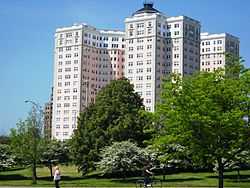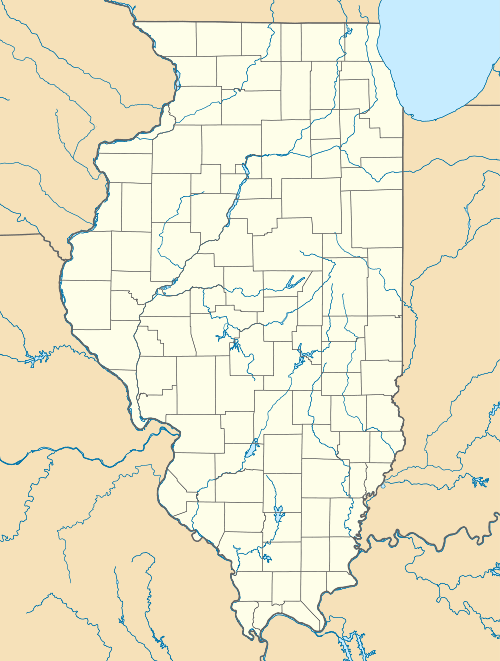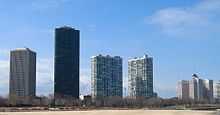Edgewater Beach Hotel
| Edgewater Beach Hotel | |
|---|---|
 View south to Edgewater Beach Hotel, before 19 story tower built (c. 1922) | |
| General information | |
| Architectural style | Spanish Colonial Revival[1] |
| Location | 5301-5355 N Sheridan Road Chicago, Illinois |
| Country | United States |
| Coordinates | 41°59′1″N 87°39′17″W / 41.98361°N 87.65472°W |
| Construction started | 1916 |
| Completed | 1923 |
| Demolished | 1970 |
| Client | John Tobin Connery and James Patrick Connery |
| Design and construction | |
| Architect | Marshall and Fox[1] |
|
Edgewater Beach Apartments | |
 | |
|
The Edgewater Beach Apartments, built in 1927, sole portion of complex now standing | |
 | |
| Location | 5555 North Sheridan Road, Chicago, Illinois |
|---|---|
| Coordinates | 41°59′1″N 87°39′17″W / 41.98361°N 87.65472°WCoordinates: 41°59′1″N 87°39′17″W / 41.98361°N 87.65472°W |
| Built | 1928 (co-op apartments) |
| Architect | Marshall and Fox |
| Architectural style | Beaux-arts / Historism[2] |
| Governing body | Private |
| MPS | Bryn Mawr Avenue Historic District |
| NRHP Reference # | 94000979 [3] |
| Added to NRHP | August 16, 1994 |
The Edgewater Beach Hotel was a hotel in the far-north neighborhood community of Edgewater in Chicago, Illinois. Designed by Benjamin H. Marshall[4] and built in 1916 for its owners John Tobin Connery and James Patrick Connery, it was located between Sheridan Road and Lake Michigan at Berwyn Avenue. An adjacent tower building was added in 1924.[5] The hotel closed in 1967, and was soon after demolished.
The Edgewater Beach Apartments were completed as part of the hotel resort complex in 1928. The "sunset pink" apartments complemented the "sunrise yellow" hotel in a similar architectural style.[6] The apartments remain standing and have been listed on the National Register of Historic Places.
History
The complex was composed of several buildings. The first building, which was built in the shape of a Maltese cross had 400 rooms. It opened in June 1916. It quickly became a success and eight years later, in 1924, a second and taller 19 story, 600-room tower was built to the south of the original. The newer, larger tower was initially called the Annex and, a passageway which became to be called the passaggio connected the two buildings.[7] It was designed by Chicago-based architects Marshall and Fox. It had a 1,200-foot private beach and offered seaplane service to downtown Chicago.[1][8] A black and white photo of the completed hotel complex tops the article for Channel 11 Chicago Stories, showing the extended Lake Shore Drive; below is a labelled photo showing the complex along its own beach.[8] When both hotel buildings were initially built, there was not much sandy beach adjacent to the hotel buildings, as shown in an aerial photo from the south; extension of Lake Shore Drive north to Foster Avenue in 1933 resulted in more sandy beach at the site, which is north of Foster along the Lake Michigan shore.[9]
During its lifetime, the hotel served many famous guests including Marilyn Monroe, Frank Sinatra, Judy Garland, Charlie Chaplin, Bette Davis, Lena Horne, Tallulah Bankhead, and Nat King Cole, and U.S. Presidents Franklin D. Roosevelt and Dwight D. Eisenhower. The hotel was known for hosting big bands such as those of Benny Goodman, Tommy Dorsey, Glenn Miller, Artie Shaw, Xavier Cugat, and Wayne King, which were also broadcast on the hotel's own radio station, a precursor to WGN with the call letters WEBH. In the winter months the bands played in the Marine Dining Room and, in the summer months, outdoors on the Beach Walk. On the first floor of the hotel, guests walked on a wooden gangway into the Yacht Club for cocktails. In the early days women were not permitted to sit at the bar. [10]
On June 14, 1949, Philadelphia Phillies first baseman Eddie Waitkus was shot and nearly killed by an obsessive fan at the hotel, 19-year-old Ruth Steinhagen; this later would be a large part of the inspiration behind Bernard Malamud's novel The Natural.[11][12]
The 1951–54 extension of Lake Shore Drive from Foster Avenue to Hollywood Avenue cut the hotel off from direct access to Lake Michigan, leading to a reduction in business. This roadway was built on landfill in the area that had been the beach for the hotel. After the hotel was cut off from the lake by the new drive, a swimming pool was added. However, this failed to help maintain its attraction as a resort. Newer hotels included air conditioning. The hotel closed in 1967 and the main buildings were demolished shortly after.[5] Loyola University used the buildings as student housing briefly; the buildings were demolished in 1970.[13]
The developers also built a sister hotel, the Edgewater Gulf Hotel, in Biloxi, Mississippi, which closed in 1970. Both projects were designed by the Chicago architectural firm of Marshall and Fox.
Apartments
The Edgewater Beach Co-op Apartments, built in 1928 at the north end of the property,[2] and shown in the photo at right, is the only part of the hotel complex to survive and is part of the Bryn Mawr Historic District. As he had before with many his other projects, such as the South Shore Country Club, the Blackstone Hotel, the Drake Hotel and Drake Tower, architect Benjamin Marshall designed the apartment building with accoutrements suited for the well-to-do.[14] It was added to the National Register of Historic Places in 1994. The apartments stand at the north end of Lake Shore Drive, quite visible to the passing traffic, and unusual in Chicago for the pink exterior.
Photo gallery
-

Then: the Edgewater Beach Hotel viewed from the north in 1923
-

Now: photograph from a similar position in 2006
-

Site of the Edgewater Beach Hotel complex viewed from the southeast in 2006
References
- ↑ 1.0 1.1 1.2 "Edgewater Beach Hotel". Emporis. Retrieved 2008-08-21.
- ↑ 2.0 2.1 "Edgewater Beach Apartments". Emporis. Retrieved 2 May 2014.
- ↑ "National Register Information System". National Register of Historic Places. National Park Service. 2007-01-23.
- ↑ The Benjamin Marshall Society "About Benjamin Marshall"
- ↑ 5.0 5.1 Enright, Laura (2005). "Architecture". Chicago's Most Wanted: The Top 10 Book of Murderous Mobsters, Midway Monsters, and Windy City Oddities. Dulles, VA: Brassey's. p. 31. ISBN 1-57488-785-8.
- ↑ http://www.encyclopedia.chicagohistory.org/pages/413.html
- ↑ "Edgewater Beach Hotel". Edgewater Historical Society. Retrieved 13 June 2014.
- ↑ 8.0 8.1 Ginny Weissman. "The Edgewater Beach Hotel: Magic by the Lake". Chicago Stories. WTTW11. Retrieved 2008-08-21.
- ↑ "Edgewater Beach Hotel". Edgewater Historical Society. Retrieved 10 May 2014.
- ↑ “Arnstein & Lehr, The First 120 Years”, (Louis A. Lehr, Jr.)(Amazon), p. 36
- ↑ Michael Lalli (June 14, 2011). "A Demented Fan and the Natural". Philly Sports History. Retrieved 8 May 2014.
- ↑ Ted Cox (May 4, 2012). "Chicago sports tragedies: off the field". Chicago Reader. Retrieved 8 May 2014.
- ↑ Hannah Lutz (January 31, 2012). "Edgewater Beach Hotel". In the Know in Ro Po. Retrieved 4 May 2014.
- ↑ Jon Andersen (January 30, 2003). "Edgewater apartments nearly back in the pink". Chicago Tribune. Retrieved 9 May 2014.
External links
- Memories of the Edgewater Beach Hotel
- Facsimile of early 1920s Brochure from the Edgewater Beach Hotel
- Vintage Image of Edgewater Beach Apartments